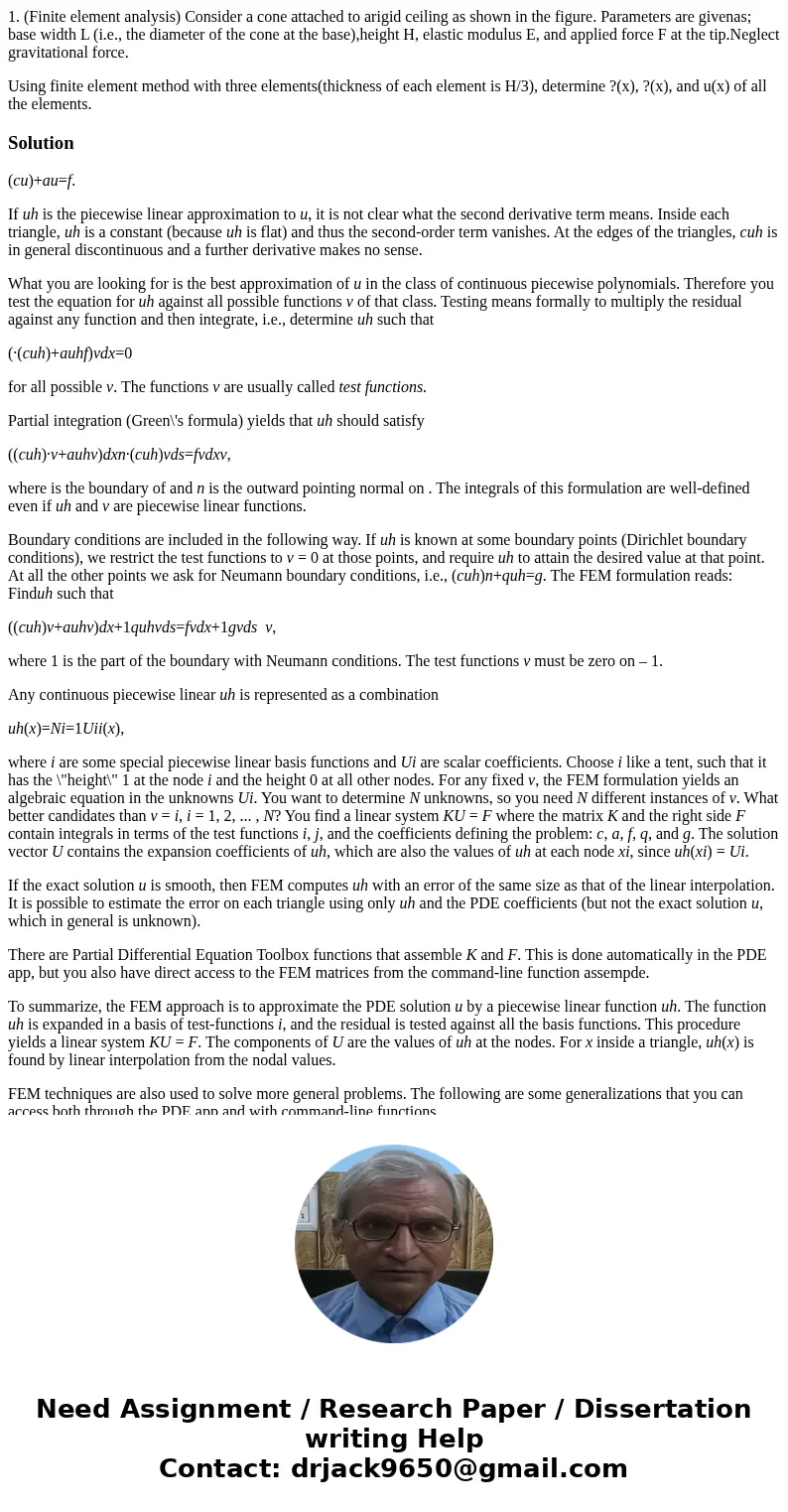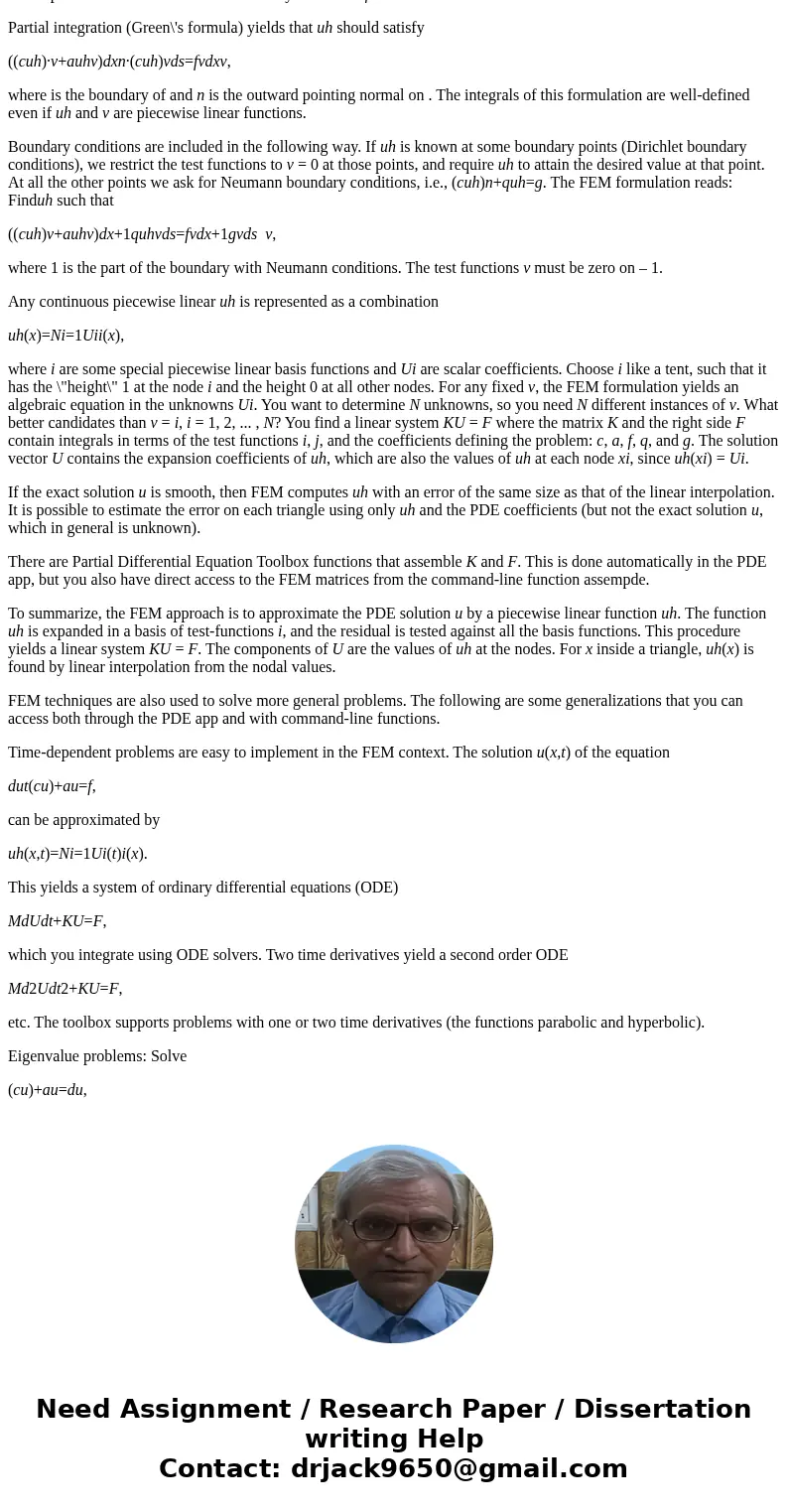1 Finite element analysis Consider a cone attached to arigid
1. (Finite element analysis) Consider a cone attached to arigid ceiling as shown in the figure. Parameters are givenas; base width L (i.e., the diameter of the cone at the base),height H, elastic modulus E, and applied force F at the tip.Neglect gravitational force.
Using finite element method with three elements(thickness of each element is H/3), determine ?(x), ?(x), and u(x) of all the elements.
Solution
(cu)+au=f.
If uh is the piecewise linear approximation to u, it is not clear what the second derivative term means. Inside each triangle, uh is a constant (because uh is flat) and thus the second-order term vanishes. At the edges of the triangles, cuh is in general discontinuous and a further derivative makes no sense.
What you are looking for is the best approximation of u in the class of continuous piecewise polynomials. Therefore you test the equation for uh against all possible functions v of that class. Testing means formally to multiply the residual against any function and then integrate, i.e., determine uh such that
(·(cuh)+auhf)vdx=0
for all possible v. The functions v are usually called test functions.
Partial integration (Green\'s formula) yields that uh should satisfy
((cuh)·v+auhv)dxn·(cuh)vds=fvdxv,
where is the boundary of and n is the outward pointing normal on . The integrals of this formulation are well-defined even if uh and v are piecewise linear functions.
Boundary conditions are included in the following way. If uh is known at some boundary points (Dirichlet boundary conditions), we restrict the test functions to v = 0 at those points, and require uh to attain the desired value at that point. At all the other points we ask for Neumann boundary conditions, i.e., (cuh)n+quh=g. The FEM formulation reads: Finduh such that
((cuh)v+auhv)dx+1quhvds=fvdx+1gvds v,
where 1 is the part of the boundary with Neumann conditions. The test functions v must be zero on – 1.
Any continuous piecewise linear uh is represented as a combination
uh(x)=Ni=1Uii(x),
where i are some special piecewise linear basis functions and Ui are scalar coefficients. Choose i like a tent, such that it has the \"height\" 1 at the node i and the height 0 at all other nodes. For any fixed v, the FEM formulation yields an algebraic equation in the unknowns Ui. You want to determine N unknowns, so you need N different instances of v. What better candidates than v = i, i = 1, 2, ... , N? You find a linear system KU = F where the matrix K and the right side F contain integrals in terms of the test functions i, j, and the coefficients defining the problem: c, a, f, q, and g. The solution vector U contains the expansion coefficients of uh, which are also the values of uh at each node xi, since uh(xi) = Ui.
If the exact solution u is smooth, then FEM computes uh with an error of the same size as that of the linear interpolation. It is possible to estimate the error on each triangle using only uh and the PDE coefficients (but not the exact solution u, which in general is unknown).
There are Partial Differential Equation Toolbox functions that assemble K and F. This is done automatically in the PDE app, but you also have direct access to the FEM matrices from the command-line function assempde.
To summarize, the FEM approach is to approximate the PDE solution u by a piecewise linear function uh. The function uh is expanded in a basis of test-functions i, and the residual is tested against all the basis functions. This procedure yields a linear system KU = F. The components of U are the values of uh at the nodes. For x inside a triangle, uh(x) is found by linear interpolation from the nodal values.
FEM techniques are also used to solve more general problems. The following are some generalizations that you can access both through the PDE app and with command-line functions.
Time-dependent problems are easy to implement in the FEM context. The solution u(x,t) of the equation
dut(cu)+au=f,
can be approximated by
uh(x,t)=Ni=1Ui(t)i(x).
This yields a system of ordinary differential equations (ODE)
MdUdt+KU=F,
which you integrate using ODE solvers. Two time derivatives yield a second order ODE
Md2Udt2+KU=F,
etc. The toolbox supports problems with one or two time derivatives (the functions parabolic and hyperbolic).
Eigenvalue problems: Solve
(cu)+au=du,


 Homework Sourse
Homework Sourse